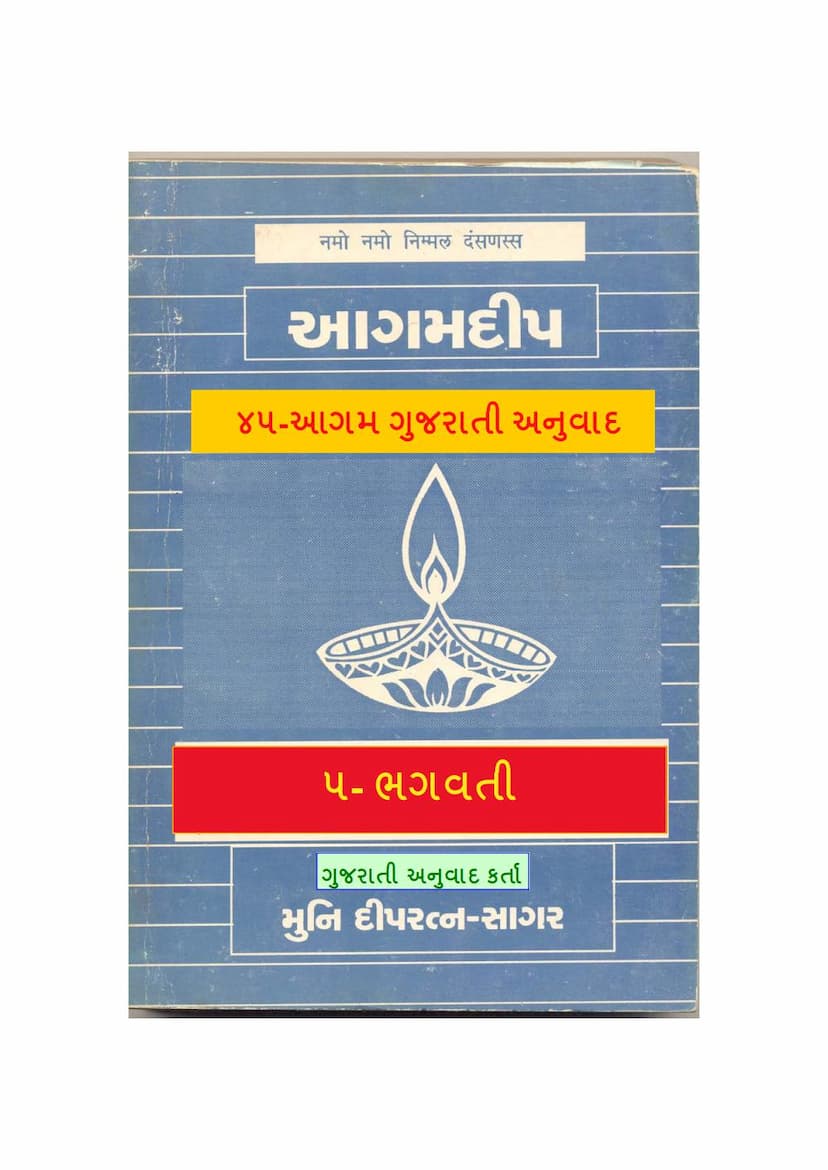Agam Deep 05 Bhagavai Gujarati Anuvaad
Added to library: September 1, 2025

Summary
This is a comprehensive summary of the Jain text "Agam Deep 05 Bhagavai Gujarati Anuvaad," based on the provided pages. Please note that the summary focuses on the content and structure as presented in the text, which primarily includes introductory pages, acknowledgments, a table of contents or index, and the beginning of the actual text.
Book Title: Agam Deep 05 Bhagavai Gujarati Anuvaad Author(s): Muni Dipratnasagar, Deepratnasagar Publisher: Agam Shrut Prakashan
Overall Purpose and Content:
The provided text is the Gujarati translation and commentary ("Gurjar Chhaya") of the Jain Agam text, Bhagavai, known in Sanskrit as Bhagavati Sutra. The book is titled "Agam Deep" and this specific volume is the fifth in the series, focusing on Bhagavai. The primary purpose of this publication is to make the profound teachings of this important Agam text accessible to the Gujarati-speaking Jain community. The author, Muni Dipratnasagar, has undertaken the translation and commentary, known as "Gurjar Chhaya."
Key Sections and Information from the Provided Pages:
-
Title and Author Information (Page 1-2):
- The title clearly indicates it's the Gujarati translation of Bhagavai (Bhagavati Sutra), part of the Agam Deep series.
- Muni Dipratnasagar is credited as the translator and commentator.
- The text begins with invocations: "Namo Namo Nirmal Dansanasya," "Namo Namo Nirmal Nanass," and salutations to various Jain Tirthankaras and spiritual preceptors, including Lord Parshvanath, Lord Neminath, and Guru Shree Sudharmasagar Suri.
-
Publisher and Publication Details (Page 2-3):
- The publisher is Agam Shrut Prakashan.
- The printing was done at Navprabhat Printing Press, Ahmedabad.
- Shri Graphics is credited with composition.
- Financial contributors and supporters of the publication are acknowledged, including Sadhviji Saumygunashriji (inspiration), along with several individuals and families from Ahmedabad and Mumbai.
- Information on how to obtain the publication is provided, including contact details and price (₹2000 for the "Agam Gurjar Chhaya" set).
-
Structure and Content Indication (Page 4-5):
- These pages appear to be a detailed index or table of contents for the "Agam Deep" series, specifically listing the contents of "Agam Gurjar Chhaya" across various volumes (Bhag 1 to Bhag 7, and further publications).
- Crucially, Page 10 onwards seems to contain the actual Gujarati translation and commentary (Gurjar Chhaya) of the Bhagavai Sutra, broken down chapter by chapter (Angas, Upangas, etc.). It lists titles like "Aayaro - Gurjar Chhaya (Agam Deep-1)," "Suyagado - Gurjar Chhaya (Agam Deep-2)," and so on, indicating the comprehensive nature of the work.
- Pages 12 onwards begin the detailed discourse, starting with the first Shatak (Chapter) and first Uddeshak (Section) of Bhagavai. This section provides a dialogue between Lord Mahavir and Gautam Swami, covering topics like:
- Salutations and basic Jain principles: Mention of Ahants, Siddhas, Acharyas, Upadhyayas, and Sadhus.
- The context of the discourse: Lord Mahavir's presence in Rajagriha, the setting of Gunsil Chaitya.
- Gautam Swami's initial questions: About the nature of existence, states of being ("Chalyu," "Udiraayu," etc.), and the classification of karmic actions and their consequences.
- Discussions on different Jiva categories: This includes detailed explanations and classifications regarding the lifespan, respiration, food intake, and karmic interactions of various beings, starting with Nairayikas (hell beings). It then progresses to Asurakumars, Nagakumars, Suryakumars, and other celestial beings, and then to earthly beings like Prithvikayika (earth element beings), Jalakayika (water element beings), Agnikayika (fire element beings), Vayukayika (air element beings), and Vanaspatikayika (plant beings). The text also delves into the characteristics of beings with different numbers of senses (Dvi-indriya, Tri-indriya, Chatur-indriya, Panch-indriya).
- Discussions on philosophical concepts: The text touches upon concepts like the nature of self (Atmarambh, Pararambh, Ubhayarambh, Anarambh), the impact of vows (Samvar, Sanyam, Virati), the nature of knowledge (Gyan) and perception (Darshan), and the path to liberation (Siddha, Buddha, Mukta).
- Detailed karmic analysis: The text explains how different karmic types are bound, experienced (Vedan), transmuted, etc., often referencing specific categories like "Sookshma" (subtle) and "Badar" (gross) pudgals.
- The dialogue format: The text is structured as a conversation, primarily between Lord Mahavir (Bhagvan) and his principal disciple Gautam Swami (Bhagvan Gautam), where Lord Mahavir explains complex Jain philosophy.
-
Key Topics Covered in the Excerpted Dialogue:
- Nirayika (Hell Beings): Their lifespan, time between breaths, sustenance, the nature of their karma (bound, experienced, transmuted), the concept of pudgals (subtle and gross) in relation to their karma, and the types of actions they perform.
- Celestial Beings (Asurakumars, Nagakumars, etc.): Their lifespan, respiration, sustenance, desires, and the nature of their karma, contrasting with Nairayikas.
- Other Life Forms: Discussions extend to Prithvikayikas, Jalakayikas, etc., and their states of existence and actions.
- Philosophical concepts: The text explores the nature of the soul, karma, liberation, and the conditions that lead to different states of rebirth.
- The role of the senses and consciousness: The text delves into how beings experience the world through their senses and consciousness.
- The nature of existence: Discussions include the concept of time, space, and the interaction of souls with karma.
- The dialogue progresses through various Shataks and Uddeshaks, indicating a systematic exploration of the Bhagavai Sutra's vast subject matter.
Overall Impression:
The provided pages demonstrate that "Agam Deep 05 Bhagavai Gujarati Anuvaad" is a scholarly and devotional effort to present a key Jain scripture in Gujarati. The meticulous detail in the table of contents and the beginning of the discourse suggests a commitment to accuracy and comprehensiveness. The text aims to provide philosophical and practical guidance rooted in Jain principles. The extensive nature of the content, even in these initial pages, highlights the depth and breadth of the Bhagavai Sutra.